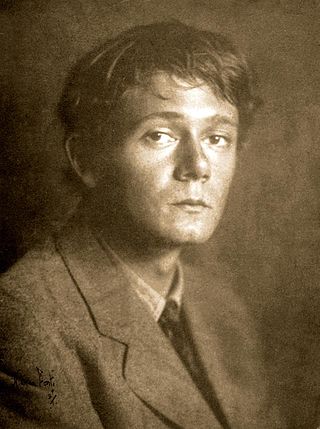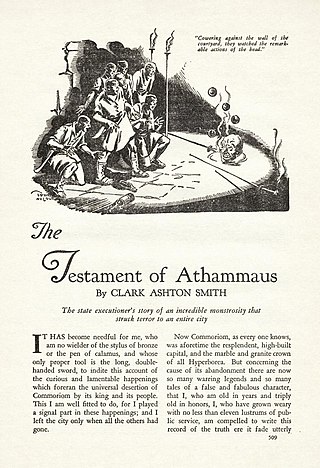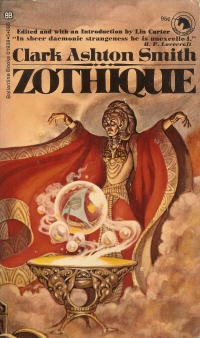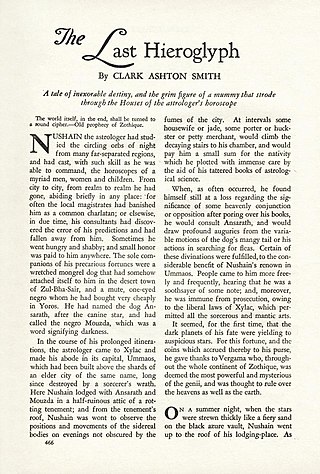
Clark Ashton Smith was an American writer and artist. He achieved early local recognition, largely through the enthusiasm of George Sterling, for traditional verse in the vein of Swinburne. As a poet, Smith is grouped with the West Coast Romantics alongside Joaquin Miller, Sterling, and Nora May French and remembered as "The Last of the Great Romantics" and "The Bard of Auburn". Smith's work was praised by his contemporaries. H. P. Lovecraft stated that "in sheer daemonic strangeness and fertility of conception, Clark Ashton Smith is perhaps unexcelled", and Ray Bradbury said that Smith "filled my mind with incredible worlds, impossibly beautiful cities, and still more fantastic creatures".

Averoigne is a fictional counterpart of a historical province in France, detailed in a series of short stories by the American writer Clark Ashton Smith. Smith may have based Averoigne on the actual province of Auvergne, but its name was probably influenced by the French department of Aveyron, immediately south of Auvergne, due to the similarity in pronunciation. Sixteen of Smith's stories take place in Averoigne. In Smith's fiction, the Southern French province is considered "the most witch-ridden in the entire country." The most well-known citizen is Gaspard du Nord of Vyones, a wizard who translated The Book of Eibon into Norman French.

The Emperor of Dreams is a collection of American fantasy author and poet Clark Ashton Smith's short tales arranged in chronological order. It was published by Gollancz in 2002 as the 26th volume of their Fantasy Masterworks series. The collection contains stories from Smith's major story cycles of Averoigne, Hyperborea, Poseidonis, and Zothique. Most of the stories originally appeared in the magazines The Fantasy Fan, Weird Tales, Overland Monthly, Strange Tales of Mystery and Terror, The Magic Carpet/Oriental Stories, The Auburn Journal, Stirring Science Stories, The Arkham Sampler, Saturn and Fantastic Universe.

"The Tale of Satampra Zeiros" is a short story written in 1929 by American author Clark Ashton Smith as part of his Hyperborean cycle, and first published in the November 1931 issue of Weird Tales. It is the story in which Smith created the Cthulhu Mythos entity Tsathoggua.

"The Testament of Athammaus" is a short story by American writer Clark Ashton Smith, part of his Hyperborean cycle. It was published in the October 1932 issue of Weird Tales.

Lost Worlds is a collection of fantasy, horror and science fiction short stories by the American writer Clark Ashton Smith. It was published in 1944 and was the author's second book published by Arkham House. 2,043 copies were printed.

A Rendezvous in Averoigne is a collection of science fiction, fantasy and horror stories by American writer Clark Ashton Smith. It was released in 1988 by Arkham House in an edition of 5,025 copies. The collection contains stories from Smith's major story cycles of Averoigne, Hyperborea, Poseidonis, Xiccarph, and Zothique. Its title story is a relatively conventional vampire story.

The following is a list of works by Clark Ashton Smith.

Zothique is a collection of fantasy short stories by Clark Ashton Smith, edited by Lin Carter. It was first published in paperback by Ballantine Books as the sixteenth volume of its Ballantine Adult Fantasy series in June 1970. It was the first themed collection of Smith's works assembled by Carter for the series. The stories were originally published in various fantasy magazines in the 1930s, notably Weird Tales.

"The Dark Eidolon" is a sword and sorcery short story by American writer Clark Ashton Smith, forming part of his Zothique cycle of stories. It was first published in Weird Tales in 1935 and has been variously republished, notably in the anthology The Spell of Seven, edited by L. Sprague de Camp.

Renegade Swords is an anthology of fantasy short stories in the sword and sorcery subgenre, edited by D. M. Ritzlin. It was first published in trade paperback and ebook by DMR Books in March 2020.

"Xeethra" is a short story by American author Clark Ashton Smith as part of his Zothique cycle, and first published in the December 1934 issue of Weird Tales.

"The Death of Ilalotha" is a short story by American author Clark Ashton Smith as part of his Zothique cycle, and first published in the September 1937 issue of Weird Tales.

"The Weaver in the Vault" is a short story by American author Clark Ashton Smith as part of his Zothique cycle, and first published in the January 1934 issue of Weird Tales.

"The Witchcraft of Ulua" is a short story by American author Clark Ashton Smith as part of his Zothique cycle, and first published in the February 1934 issue of Weird Tales.

"The Charnel God" is a short story by American author Clark Ashton Smith as part of his Zothique cycle, and first published in the March 1934 issue of Weird Tales.

"The Black Abbot of Puthuum" is a short story by American author Clark Ashton Smith as part of his Zothique cycle, and first published in the March 1936 issue of Weird Tales.

"The Last Hieroglyph " is a short story by American author Clark Ashton Smith as part of his Zothique cycle, and first published in the April 1935 issue of Weird Tales.

"The Isle of the Torturers" is a short story by American author Clark Ashton Smith as part of his Zothique cycle, and first published in the March 1933 issue of Weird Tales.

"The Voyage of King Euvoran" is a short story by American author Clark Ashton Smith as part of his Zothique cycle. It was first published as "The Voyage of King Euvoran" in the 1933 book The Double Shadow and Other Fantasies. It was republished as "Quest of the Gazolba" in the September 1947 issue of Weird Tales where it was the cover story with art by Boris Dolgov.




















